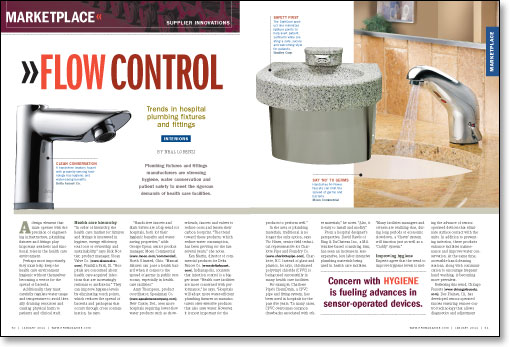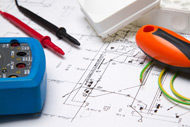Plumbing fixtures and fittings manufacturers are stressing hygiene, water conservation and patient safety to meet the rigorous demands of health care facilities.
A design element that must operate with the precision of engineering infrastructure, plumbing fixtures and fittings play important aesthetic and functional roles in the health care environment.
Perhaps most importantly, they must help keep the health care environment hygienic without themselves becoming a vector for the spread of bacteria.
Additionally, they must carefully regulate water usage and temperature to avoid literally draining resources and causing physical harm to patients and clinical staff.
Health care hierarchy
"In order of hierarchy, the health care market for fixtures and fittings is interested in hygiene, energy efficiency, total cost of ownership and sustainability," says Rick Nortier, product manager, Sloan Valve Co. (www.sloanvalve.com), Franklin Park, Ill. "Hospitals are concerned about health care-acquired infections that are increasingly resistant to antibiotics." They can improve hygiene levels by eliminating touch points, which reduces the spread of bacteria and pathogens that occurs through cross contamination, he says.
"Hands-free faucets and flush valves are a big trend for hospitals, both for their hygienic benefits and water-saving properties," adds George Spear, senior product manager, Moen Commercial (www.moen.com/commercial ), North Olmsted, Ohio. "Manual fixtures can pose a health hazard when it comes to the spread of germs in public restrooms, especially in healthcare facilities."
Amy Thompson, product coordinator, Speakman Co. (www.speakmancompany.com), New Castle, Del., sees more hospitals requiring lower-flow water products such as showerheads, faucets and valves to reduce costs and lessen their carbon footprint. "The trend toward these products, which reduce water consumption, has been growing for the last several years," she notes.
Ken Martin, director of commercial products for Delta Faucet Co. (www.deltafaucet.com), Indianapolis, counters that infection control is a bigger issue. "Health care facilities are more concerned with performance," he says. "Hospitals will adopt more water-efficient plumbing fixtures as manufacturers offer effective products that also save water. However, it is most important for the products to perform well."
In the area of plumbing materials, traditional is no longer the only option, says Vic Hines, senior field technical representative for Charlotte Pipe and Foundry Co. (www.charlottepipe.com), Charlotte, N.C. Instead of glass and plastics, he says, chlorinated polyvinyl chloride (CPVC) is being used successfully in many health care facilities.
For example, Charlotte Pipe's ChemDrain, a CPVC pipe and fitting system, has been used in hospitals for the past five years. "In many cases, CPVC overcomes common drawbacks associated with other materials," he notes. "Also, it is easy to install and modify."
From a hospital designer's perspective, David Rawls of Ring & DuChateau Inc., a Milwaukee-based consulting firm, has seen an increase in less-expensive, less labor-intensive plumbing materials being used in health care facilities. "Many facilities managers and owners are realizing that, during long periods of economic slowdown, a 'Chevy' system will function just as well as a 'Caddy' system."
Improving hygiene
Experts agree that the trend to improve hygiene levels is fueling the advance of sensor-operated devices that eliminate surface contact with the units. In addition to preventing infection, these products enhance facilities maintenance and improve water conservation. At the same time, accessible hand-cleaning stations, along with communication to encourage frequent hand washing, is becoming more prevalent.
Reflecting this trend, Chicago Faucets (www.chicagofaucets.com), Des Plaines, Ill., has developed sensor-operated faucets featuring remote-control technology that allows diagnostics and adjustment from a handheld-enabled device, according to John Fitzgerald, vice president of marketing. Several models incorporate settings for scrub sinks and scheduling of regular faucet flushing, he says.
Adding antimicrobial elements to touch points is another trend in addressing infection control, says Will Haas, product manager, Bradley Corp. (www.bradleycorp.com), Menomonee Falls, Wis. For example, Bradley's Terreon bathroom products are nonporous and inhibit the growth of bacteria beginning when microorganisms first come into contact with the surface. "It's important to use antimicrobial protection that lasts the lifetime of the product," he notes.
In a related vein, VitrA USA (www.vitra-usa.com), Suwanee, Ga., incorporates bacteria-resistant glazes to its bathroom surfaces to stop the spread of infections, says Dawn Robinson, special marketing programs manager.
"Our VitrA hygiene technology adds silver ions to the glaze on the ceramic, which makes it difficult for bacteria to breathe on its surface," she explains. "This kills 99.9 percent of bacteria that come in contact with the ceramics."
Conservation focus
Innovations in water conservation focus on plumbing fixtures that operate on demand as well as lower flow rates and flush control. For example, Alsons Corp. (www.alsons.com), Hillsdale, Mich., has developed an ActivTouch hand shower that facilitates water conservation. "The pause-control button allows the user to reduce flow to a trickle when full water is not needed," explains John Davies, vice president, sales.
Water-saving urinals from Gerber Plumbing Fixtures (www.gerberonline.com), Woodridge, Ill, also reflect this trend. The company's North Point urinals use 0.125 gallons of water per flush. "They perform better than waterless urinals because the flush allows the least amount of water to effectively remove waste. This is important in health care environments where excessive flushing is common," says Kevin McJoynt, vice president of marketing.
Winston Huff, project manager with Smith Seckman Reid Inc., a consulting firm based in Nashville, Tenn., says, "Some low-flow toilets work very well and use less than 1.6 gallons of water per flush, but many hospitals are reluctant to use them because they don't know how well the new fixtures will remove waste from the trap. However, they are using dual-flush toilets that have the full 1.6-gallon flush while obtaining LEED (Leadership in Energy and Environmental Design) credits."
Careful planning and execution still is required to make the best use of these products, says Rawls of Ring & DuChateau Inc. "With the two-edged sword of increasing utility rates and diminishing water supplies, it is essential to provide the most efficient water-saving fixtures and trim as possible," he remarks. "This needs to be a four-squared effort among the owner, architect, engineer and contractor."
Environmental concern
"Hospitals are one of the largest municipal water and sewer customers, as well as one of the largest energy customers, in their communities," Huff says. Despite such challenges, facilities managers are striving to make their operations environmentally friendly.
According to Sloan's Nortier, doing more with less has been a priority for some time and the movement toward high-efficiency fixtures has become well-established over the past few years.
"While the impact can be greater in water-deficient regions, it is center stage with architects and specifiers interested in LEED," he says. "While the LEED initiative started in the commercial area, it is gaining momentum in health care. Many commercial solutions can be applied to health care environments, but not all should. For example, 0.5-gpm faucets can save water in public restrooms. However, placed in such settings as scrub stations, they can compromise hand-washing results." Nortier also warns that reduced water use at the faucet can hinder the control of Legionella, which thrives in stagnant water.
Reducing plastic waste in public landfills is a green benefit of a bottle-filling station produced by Halsey Taylor (www.halseytaylor.com), Oak Brook, Ill. The station provides hospital end-users with cold, filtered water for bottles and cups, which eliminates the need to discard plastic water bottles. To help convey the environmental impact of using the filling station, a "green counter" displays the number of disposable water bottles that have been saved from landfills, says Rod Magnuson, director of commercial products.
Vacuum plumbing systems, which can be routed above ground, offer an environmentally friendly alternative to gravity drainage, says Tony Catroppa, vice president, Whitehall Manufacturing (www.whitehallmfg.com), City of Industry, Calif., and allow more flexibility in system design and installation.
"Vacuum plumbing may be specified for new construction or retrofit projects to earn LEED certification," Catroppa explains. "It only requires one-half gallon per flush, whereas the average low-flow toilet still requires 1 gallon. Also, because the entire system is installed above ground, contractors don't have to X-ray the existing post-tension slab for reinforcement, or plan around existing buried utilities or soil conditions."
In fact, Whitehall supports an overall strategy when installing plumbing fixtures and fittings in hospitals. Selection of low-flow fixtures is important, but many other factors must be addressed.
"A hospital's budget, design constraints, durability requirements and cleanliness are part of the bigger picture," Catroppa notes. "We support the shift to products that consider these concerns 'all in one,' while reducing a negative impact on the environment."
Safety is key
Anti-scald shower valves are a key to ensuring safety, experts agree. These products reduce the chance of thermal shock and scalding, traditionally the cause of many bathing-related accidents. Also, sensor-operated faucets prevent water overrun—the cause of wet, slippery floors. Minimized ligature points is another safety feature, which can prevent patient injury and self-harm.
"Anti-scald shower valves are important in health care facilities because users often have compromised mobility and are more susceptible to scalding," says Delta's Martin. "Both pressure balance and thermostatic valves reduce that risk." Delta offers several thermostatic mixing valves for lavatory use, which control maximum hot-water temperature, plus pressure-balance and thermostatic shower valves.
Similarly, Moen Commercial faucets feature a thermostatic mixing valve designed to prevent scalding and shock during hand washing. This valve blends hot water — stored at temperatures high enough to kill bacteria — with cold water to ensure constant, safe temperatures and prevent the spread of disease.
Chicago Faucets also offers thermostatic mixing valves for its sensor-operated faucets to ensure precise control of temperature at the outlet.
Symmons Industries Inc. (www.symmons.com), Braintree, Mass., offers a "safe shower" experience, according to Beth Mercurio, vice president of marketing.
"The company's premium trim plates are compatible with their anti-scald, pressure-balance valve," she notes. "This opens up new design options for a less commercial look."
Another Symmons product popular in the health care industry is the Visu-Temp with Clear-Vue shower system which displays the water temperature through a clear gauge for added safety.
The minimization of ligature points in product design, which means that connection points are concealed and cannot be tampered with, is an important feature of Bradley's anti-ligature series, which includes hand-washing, shower and accessory options.
For example, lavatory features — contoured design, fully enclosed plumbing via a stainless steel trap cover, and spray-head faucet mounted flush to the basin — all minimize ligature points, which prevent injuries and patient self-harm, says Haas.
Keep striving
As plumbing manufacturers keep striving to meet health care's rigid requirements, these issues will continue to be at the top of their product agendas.
Neal Lorenzi is a freelance writer based in Mundelein, Ill.
| Sidebar - For more information |
| For information on the plumbing fixtures and fittings discussed in this month's "Marketplace," readers can contact the following manufacturers: Alsons Corp. Bradley Corp. Charlotte Pipe Chicago Faucets Delta Faucet Co. Gerber Plumbing Fixtures Halsey Taylor Moen Commercial Sloan Valve Co. Speakman Co. Symmons Industries Inc. VitrA USA Whitehall Manufacturing |





